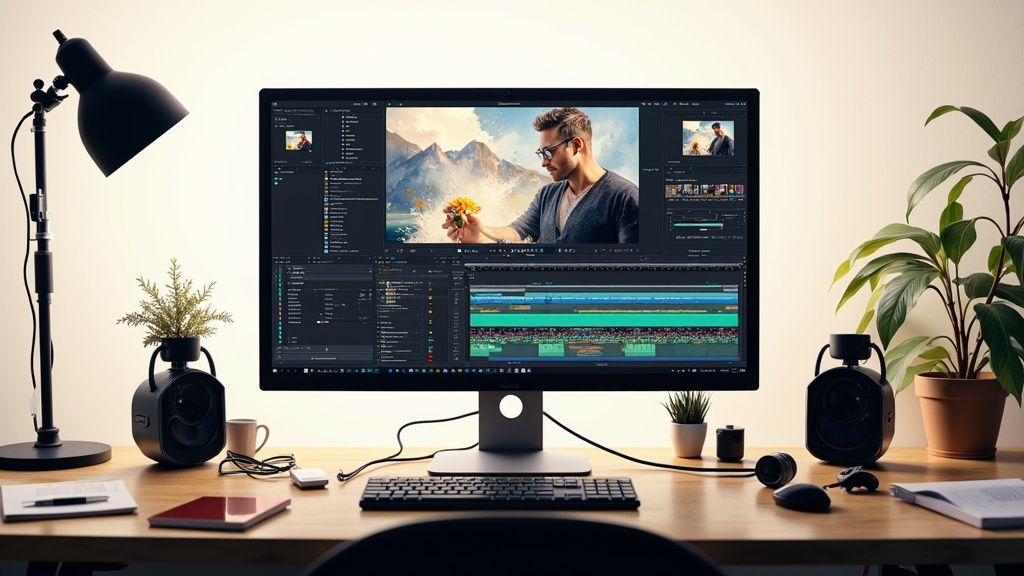Navigating the Evolving Landscape of Video Production

The video production world is constantly changing. New platforms, technologies, and audience expectations mean producers need to be adaptable. This makes video production project management essential for success. Traditional methods often struggle to keep up, presenting unique challenges for video teams striving for quality.
The Multi-Platform Challenge
One of the biggest changes is the sheer number of platforms where video content lives. A single video needs to be optimized for everything from YouTube and Facebook to Instagram and TikTok. Think about it: a widescreen video might need tweaking for Instagram's square or vertical format. Each platform also has its own technical specifications.
This need for multiple versions adds complexity. It increases workload and puts pressure on deadlines. In 2023, transforming a single video into multiple outputs became commonplace, increasing workload and pressuring timelines. This makes efficient video production project management a must.
Streamlined workflows and standardized processes are essential for on-time delivery. Studies show automated workflows can cut turnaround time by up to 35%. Explore this topic further
Adapting to Condensed Timelines
Along with the multi-platform demand comes shrinking deadlines. Clients expect fast turnarounds, pushing production teams to work faster. This demands efficient workflows and crystal-clear communication.
Think of a car assembly line: a slowdown in one area impacts the entire production. Similarly, delays in one stage of video production create a ripple effect, delaying the whole project.
The Need for Specialized Management
These evolving demands highlight the need for specialized video production project management. Effective management keeps projects on track, on budget, and aligned with creative goals. It requires detailed planning, open communication, and the right tools.
Proactive risk management is also essential for anticipating and addressing potential roadblocks. Strong leadership is key to guiding teams, navigating challenges, and creating a collaborative environment. By adapting their project management techniques, production houses can thrive in this demanding landscape and consistently deliver exceptional video content.
Building the Foundation: Core Elements That Drive Success

What takes a video project from initial idea to captivating final product? The answer lies in effective video production project management. This involves mastering several key components, which form the basis of any successful production. These elements allow for creative flexibility while maintaining accountability, ultimately leading to impactful results.
Budget Tracking and Scope Management
Think of budget management in video production like building a house: a detailed blueprint (budget) is essential to guide spending and avoid costly overruns. Meticulous budget tracking, comparing anticipated costs with actual expenditures, helps prevent scope creep. Scope creep occurs when project requirements expand beyond the initial agreement, similar to adding unplanned rooms to your house—increasing both cost and completion time.
Resource Allocation
Resource allocation is about having the right tools and team members available at the right time. It's about maximizing team capacity through careful planning. This involves assigning tasks based on individual skills and experience, and avoiding overbooking resources. Just as a carpenter needs the right hammer, a video editor needs suitable software like Adobe Premiere Pro and sufficient processing power. This efficient approach minimizes downtime and keeps the project on schedule.
Timeline Strategies
Timelines in video production are rarely linear. They require flexibility to accommodate the often unpredictable nature of creative work. However, a structured approach is still essential. Developing realistic timelines that factor in potential delays and revisions helps keep everyone aligned and the project on track. It's like planning a road trip: you need a route and estimated travel time, but also the flexibility to handle unexpected detours.
To help visualize the interconnectedness of these core elements, let's look at a breakdown in the following table:
Video Production Management Components
A comprehensive breakdown of essential elements in successful video production project management.
| Component | Function | Impact on Project Success |
|---|---|---|
| Budget Tracking | Monitors expenses against planned budget | Prevents cost overruns and maintains financial viability |
| Scope Management | Controls project requirements and changes | Avoids scope creep and ensures project stays on target |
| Resource Allocation | Assigns personnel and equipment effectively | Maximizes team productivity and minimizes downtime |
| Timeline Management | Develops and maintains a realistic project schedule | Keeps the project on track and facilitates timely completion |
This table illustrates how each component plays a crucial role, contributing to a well-managed and successful video production process. By understanding these connections, project managers can better anticipate challenges and ensure smooth execution.
Integrating Components for Cohesion
Integrating these components creates a cohesive framework. This supports both technical excellence and creative freedom, acting as a roadmap to guide all stakeholders towards a shared vision. Project management becomes a critical factor in ensuring projects are completed on time and within budget. Surprisingly, only 58% of organizations fully understand the value of project management (Source), leading to missed opportunities in optimizing workflows. In video production, this can lead to miscommunication and redundant efforts. Implementing standardized project management practices, often using tools that improve communication and task management, can help mitigate these risks.
Practical Application
Leading studios recognize the importance of a robust management system. They build systems that allow for creative exploration while maintaining accountability. Clear communication channels are key, ensuring everyone is informed about project updates and potential roadblocks. This fosters a collaborative environment where creativity can flourish and project goals are consistently met. For further insights on budgeting, check out this resource: How to Budget Your Next Video Project Like a Pro
By mastering these fundamental elements, video production teams can navigate the complexities of their projects with confidence, ensuring successful outcomes that exceed expectations. This solid foundation empowers them to focus on their core strength: crafting compelling and engaging video content.
Leveraging Technology To Transform Your Video Production Process

The right technology can dramatically improve video production project management. Instead of chaotic workflows, you can achieve smooth and efficient delivery. This involves selecting and integrating tools specifically designed for video production, addressing common challenges like version control, feedback processes, and team communication. Ultimately, these solutions help bridge the gap between your creative vision and efficient project execution.
Streamlining Workflows With Project Management Platforms
Imagine a complex video project as a large orchestra. Numerous instruments (team members) must play together harmoniously to create a beautiful symphony (the final video). Project management platforms act as the conductor, coordinating all the moving parts and ensuring everyone is on the same page.
These platforms offer a centralized hub for communication, file sharing, and task management. They help eliminate the confusion caused by scattered emails and disorganized spreadsheets.
Leading companies use platforms like Notion and Monday.com to create custom dashboards that organize their video production processes. These dashboards provide a visual overview of project timelines, budgets, and resource allocation. This allows for quick identification of potential bottlenecks and facilitates informed decision-making. You might also find this interesting: How AI Is Transforming Video Quality.
Enhancing Collaboration With Asset Management and Communication Tools
Collaboration is essential for successful video production. Asset management systems simplify this process by providing a secure, central location for storing and sharing important files. These assets include video files, scripts, storyboards, and more. This centralized system ensures everyone accesses the latest versions, minimizing confusion and costly errors.
For example, consider a team working on a video with multiple revisions. An asset management system acts as a single source of truth. This prevents team members from accidentally working on outdated files, ensuring everyone stays aligned.
Additionally, robust communication tools like Slack and Microsoft Teams streamline communication within the team and with external stakeholders. Real-time chat, file sharing, and video conferencing features keep everyone connected, regardless of their location, creating a truly collaborative environment.
This interconnected approach makes feedback much easier. Team members and clients can easily provide feedback on drafts and revisions directly within the platform, eliminating long email chains or confusing annotations on multiple file versions.
The use of technology in video production project management is clearly increasing. The project management software market is expected to reach USD 15.06 billion by 2032, growing at a CAGR of 18.48% from 2024. Interestingly, only 22% of organizations currently use specialized project management software. This suggests a significant opportunity for improved efficiency and productivity. Find more detailed statistics here.
Implementing Technology For Maximum Impact
Successfully implementing new technology requires careful planning. Minimizing disruptions to your team during implementation is essential. This means selecting tools that fit into existing workflows, rather than forcing significant changes.
Proper training and ongoing support are also key. This ensures the team fully understands and effectively uses the new tools. It's similar to furnishing a house; you wouldn't buy furniture that doesn't fit the space or your lifestyle. Likewise, you need to select technology that aligns with your team's current processes and boosts their productivity.
By strategically integrating these technological solutions, video production teams can create a more efficient, collaborative, and ultimately more successful production process. The result is a smooth workflow that encourages creativity, reduces errors, and ensures projects are delivered on time and within budget. This integrated approach helps realize the full potential of technology, improving every step of video production.
Crafting Workflows That Actually Work

Effective video production project management relies heavily on well-defined workflows. This section explores practical strategies for crafting workflows that tackle real-world production hurdles. We'll delve into how successful companies design efficient processes, balancing structure with the flexibility essential for creative work.
Mapping Dependencies and Identifying Bottlenecks
Video production is like a relay race. Each stage relies on the successful completion of the previous one. Mapping these dependencies—pre-production, production, and post-production—provides a visual overview of the entire process. This allows project managers to pinpoint potential bottlenecks early on.
For example, imagine a delay in script approval. This single snag can ripple through the entire production schedule. By understanding these interdependencies, project managers can proactively mitigate potential delays. This foresight ensures a smoother and more efficient workflow.
Approval Processes That Maintain Creative Integrity
Approval processes are vital for quality control without stifling creative vision. Think of it as a chef tasting a dish before it goes out to diners. Establishing clear approval stages – script, storyboard, rough cut, and final cut – provides stakeholders with opportunities to give feedback at critical junctures.
This structured feedback process safeguards the creative vision by preventing last-minute changes. Such changes often compromise the overall project. Furthermore, defined approval stages manage expectations and avoid endless revisions, keeping projects on schedule.
Documenting Workflows for Consistency
Documented workflows guarantee consistency across projects and teams. They serve as a roadmap, outlining standard procedures and best practices. This isn't about creating rigid, inflexible rules. Instead, documentation provides a flexible framework that can be tailored to suit different project needs.
For instance, a documented workflow might detail the standard steps for script development, from the initial brainstorming session to final approval. This level of detail simplifies onboarding for new team members and ensures consistent quality across projects. For further reading, check out this blog post: How to Master Media Workflow Automation.
Continuous Improvement Through Data and Feedback
Effective workflows are dynamic, evolving based on data and feedback. Just like a gardener pruning a plant to encourage growth, regularly analyzing production data—time spent on each stage, budget adherence, and client satisfaction—reveals areas ripe for improvement.
Suppose post-production consistently exceeds its allocated time. This could signal the need for additional resources or a workflow adjustment. Team feedback also plays a crucial role. Regularly gathering feedback from the team about the workflow can uncover pain points and highlight opportunities for optimization. This iterative approach refines the workflow over time, boosting efficiency and delivering higher quality results.
Balancing Structure and Flexibility
Successful video production workflows strike a balance between structure and flexibility. Too much structure can stifle creativity, while too little can lead to disorganization. A jazz band provides a good analogy. They operate within a structure – the melody and rhythm – but have the freedom to improvise within those boundaries.
Similarly, video production workflows should provide a framework that guides the process while still allowing for creative problem-solving and adaptability when unexpected challenges arise. This balance keeps projects on track while nurturing the creative spark that produces engaging content.
Comparing Traditional and Optimized Workflows
To see the tangible benefits of an optimized workflow, let's compare a traditional approach with an optimized one:
To illustrate the advantages of an optimized approach, let's examine a comparison table.
Video Production Workflow Comparison
| Production Stage | Traditional Approach | Optimized Workflow | Time Savings |
|---|---|---|---|
| Pre-Production | Lengthy meetings, scattered feedback | Centralized communication, clear approvals | 20-30% |
| Production | On-set confusion, reactive problem-solving | Detailed planning, proactive risk management | 10-15% |
| Post-Production | Multiple revisions, slow turnaround | Streamlined feedback, efficient editing | 15-20% |
This table clearly shows how an optimized workflow, emphasizing clear communication, streamlined processes, and proactive planning, can dramatically reduce production time without compromising quality. By embracing these strategies, video production teams can build workflows that not only function effectively but also flourish, resulting in better content, satisfied clients, and a more rewarding creative experience.
Leading Creative Teams Without Crushing Creativity
Managing creative teams, especially in the dynamic world of video production, requires a nuanced approach. It's a delicate balancing act between nurturing creative freedom and adhering to the practical constraints of video production project management. This section explores how to effectively lead these teams, fueling their creative energy while ensuring projects stay on course and within budget.
Communication Frameworks That Bridge the Gap
Effective communication is the bedrock of any successful video production. This means establishing crystal-clear communication channels between the creative team, technical specialists, and stakeholders. Imagine these groups as distinct islands, each possessing specialized skills and perspectives. The bridges connecting them are the pathways of clear and consistent communication, facilitating a smooth flow of information and preventing misunderstandings.
This collaborative approach fosters transparency and keeps everyone in the loop. Project updates, potential roadblocks, and any shifts in direction are shared openly. This shared understanding is essential for maintaining momentum and avoiding costly rework down the line.
Setting Clear Expectations and Providing Constructive Feedback
Just as a ship needs a charted course, a video production team needs clearly defined goals and deliverables from the very beginning. This clarity ensures everyone understands the project’s objectives and their individual roles in achieving them. This prevents confusion and keeps the project focused.
Providing constructive feedback is a true art form. It's about guiding creative output without stifling the innovative spark. Think of it as nurturing a plant – providing the right support and nourishment to encourage healthy growth. Feedback should be specific, actionable, and aimed at improving the work, not criticizing the individual.
Managing Revision Cycles Efficiently
Revisions are a natural part of the video production process. However, if left unchecked, they can quickly derail timelines and budgets. Think of revisions as sculpting – each iteration refines the piece and brings it closer to the final vision. Too many, however, can chip away at the project’s foundation.
Effective video production project management involves implementing a clear revision process with defined stages and feedback loops. This structured approach helps manage client expectations, prevents endless back-and-forths, and guarantees that revisions contribute positively to the final product.
Resolving Creative Differences and Building Consensus
Creative differences are inevitable in any collaborative environment. However, these differences can escalate into conflicts if not addressed constructively. Effective leadership involves mediating these disagreements and building consensus around key project decisions. It's akin to conducting an orchestra, ensuring each instrument harmonizes to create a beautiful melody.
Building consensus requires actively listening to diverse perspectives, understanding the rationale behind each viewpoint, and finding common ground that propels the project forward. This approach cultivates a positive and collaborative atmosphere where creativity can thrive.
Maintaining a Collaborative Environment for Compelling Content
A collaborative environment is the lifeblood of compelling video content. It's the fertile ground where creative ideas flourish and innovative solutions take root. Picture it as a vibrant ecosystem – diverse elements interacting to create something greater than the sum of its parts.
This positive environment fosters a sense of shared ownership, motivating team members to contribute their best work. It encourages open communication, promotes experimentation, and celebrates achievements. By prioritizing the human element and fostering a collaborative environment, video production teams can navigate the creative process more effectively. The result? Outstanding content that resonates with audiences. This approach beautifully balances creative vision with project constraints, ensuring the final product is both artistically compelling and realistically achievable.
Preparing for the Unexpected: Risk Management That Works
Even with the most detailed planning, unexpected issues can pop up in video production. This makes risk management a crucial part of video production project management. This section provides a practical way to identify and mitigate potential risks, turning small problems into manageable challenges.
Identifying Common Failure Points
Every production phase has its potential pitfalls. Pre-production risks could include script delays or talent not being available. Production can be affected by equipment malfunctions or bad weather. Post-production might face software problems or hard drive crashes. Recognizing these common issues is the first step in effective contingency planning.
Contingency Strategies: Turning Problems into Solutions
Backup plans are essential for mitigating risk. Having backup equipment on set can prevent technical issues from ruining a shoot. Adding buffer time to the schedule allows for unexpected delays without affecting the deadline. Effective leadership ensures the team is prepared for anything. Consider this resource on practical call center training. Just as well-trained agents handle unexpected customer interactions, a prepared production team can navigate unforeseen challenges.
Building Flexibility Into Production Schedules
Think of your schedule as a roadmap. It guides the journey but needs to allow for detours. Building in flexibility means adding buffer time between tasks. This provides room for unexpected delays without impacting the overall timeline. It's like adding extra time to your commute in case of traffic.
Managing Scope Expansion Requests
Scope expansion, also known as scope creep, happens when project requirements grow beyond the initial agreement. This can strain the budget and timeline. Managing these requests requires clear communication with the client. Discussing the impact of scope changes—like increased cost and time—helps manage expectations and maintain project viability. It's like adding features to a custom-built house – each addition increases the final cost.
Risk Matrices Tailored to Production Type
Different productions face unique risks. A corporate video shoot has different challenges than a documentary filmed in multiple locations. A risk matrix assesses and prioritizes risks based on their likelihood and impact. This targeted approach ensures preparedness for specific challenges without overcomplicating things. A small studio shoot will need less elaborate contingency planning than a large-scale outdoor production.
Backup Plans for Technical Failures
Technical failures can be disastrous, especially during production. Backup equipment is only part of the solution. Regularly testing equipment before each shoot is critical for early problem identification. For digital productions, keeping multiple backups of footage protects against data loss. It’s like having a spare tire – you might not need it often, but it’s essential in an emergency.
By proactively addressing potential risks, video production project management becomes more robust and resilient. This preparation allows teams to handle unexpected challenges, minimizing disruptions and delivering successful projects on time and within budget. This approach doesn't just solve problems; it prevents them from becoming major setbacks.
From Implementation To Transformation: Making It Real
Successfully changing how you manage video production projects involves more than just knowing the theory – it's about putting those plans into action. Introducing new management methods requires clear communication, practical steps, and a pace the entire team can handle comfortably.
Gaining Authentic Team Buy-In
Getting your team on board with new strategies starts with open communication. Explain the why behind the new approach and how it directly addresses daily challenges. This builds trust and makes everyone feel involved.
Some key actions include:
- Sharing success stories from similar projects.
- Clearly outlining roles and responsibilities.
- Holding interactive sessions to address any concerns.
This fosters a supportive environment where team members see improvements as beneficial to them personally. With each contribution, change becomes less of a mandate and more of a collaborative effort.
Establishing Meaningful Metrics
Instead of simply measuring activity, concentrate on metrics that reflect real progress. Track indicators that capture improvements in efficiency, output quality, and team responsiveness. Some helpful metrics might be:
- Decreased project turnaround times.
- Improved accuracy in meeting deadlines.
- Better quality reviews and fewer revisions.
These metrics serve as valuable checkpoints. They not only track progress but also provide crucial feedback, allowing for real-time adjustments. Data-backed results make discussions about future changes more focused and confident.
Creating a Culture of Continuous Improvement
A gradual rollout of new methods is crucial. As production demands grow, introduce new practices step by step. Document best practices through:
- Written guidelines explaining new processes.
- Checklists for new team members.
- Regular review sessions to adapt processes based on actual challenges.
This creates a dynamic set of standards that evolves with the team. This system helps avoid burnout from sudden changes and fosters a constructive feedback loop.
Implementing these strategies transforms video production project management from theory to daily practice. Over time, the team not only adopts new methodologies but also refines them based on practical experience.
Ready to put these principles to work? Discover how Aeon, a comprehensive video creation platform, can support these changes and boost your production efficiency. Explore Aeon and start your journey